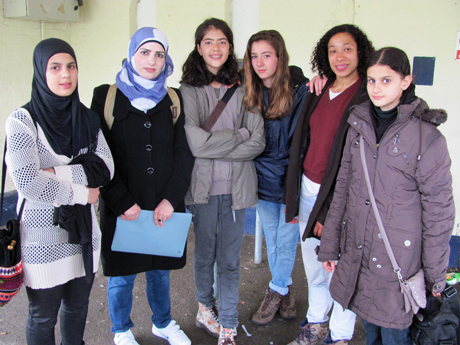What’s life like as a child living in the Occupied Palestine Territories? – review

Maram, Asma, Zohra and Melanie (two schoolgirls from Parliament Hill School in Camden), Bibsi Haywill, (helper from Hackney) and Yara.
Asma is 21 years old, an English teacher and mother of two. Like so many parents Asma achieves the seemingly impossible and successfully balances the often all-encompassing spheres of work and family.
Yet Asma is different: Over two thousand miles from home, looking after children that are not hers, and speaking to people she does not know in a language that is not her own.
Asma is a Palestinian, and as is typical of this proud and defiant people she has taken a leap into the unknown, equipped with courage, intelligence and a determination to tell her, nay, the Palestinian story, or at least one of them.
On 12 July, Asma, along with Maram and Yara, both fourteen and pupils at the UNWRA School in the Palestinian Village of Beit Sourik at which Asma teaches, gave a moving talk to a large and willing crowd at the Dalston CLR James Library.
The event, titled What’s life like as a child living in the Occupied Palestine Territories?, was hosted by the Beit Sourik Hackney Friendship Association and was part of a larger initiative organised by the Camden Abu Dis Friendship Association that brought young people over from Palestine to spend time with Londoners of a similar age with the intention of learning “about each other’s very different lives”.
The initiative lasted two weeks and saw sixteen Palestinians, many of them aged between thirteen and sixteen, follow a hectic but nonetheless enjoyable schedule that would put most politicians – the same politicians who so often ignore their voices—to shame.
The last time Dalston Library hosted a similar event a complaint was lodged by the Hackney Anglo-Israel Twinning Association accusing the library of “one-sidedness.”
Yet listening to Asma, Yara and Maram it was clear that this was not about sides, and these extraordinary women were most certainly not pushing a competing political agenda. This was an evening devoted to a very human story, the story of the people—people no different from you or I – of Beit Sourik.
Beit Sourik lies just twelve kilometres Northwest of Jerusalem yet of more immediate geographical concern is the twenty-foot high wall – declared illegal by the International Court of Justice – that has been erected in Palestinian territory by the Israeli government and which now casts a morbid shadow over the surrounding landscape.
The ‘segregation wall’, as it has become known, surrounds and pierces through the heart of Beit Sourik, preventing the villagers from accessing the majority of their agricultural land: a crushing and potentially fatal blow to a community whose livelihood is overwhelmingly dependent on farming.
Over the course of the evening those in attendance at Dalston Library were given an insight into life in Beit Sourik and the hardships that its inhabitants, old and young, encounter: Journeys that should take minutes are made unbearably lengthy by Israeli checkpoints and stringent identification requirements, and access to hospitals and schools has become increasingly difficult and in some cases impossible. Yet these stories, delivered with defiance and courage, illustrate but an inch of life in Beit Sourik.
As the meeting drew to a close the audience, captivated and unsettled, began to ask questions, the most common of which was “what can we do to help?”
The answer they received was simple: “Educate”, educate people on the plight of the villagers of Beit Sourik and their Palestinian brothers and sisters, be it politicians, friends or neighbours, and do so until they begin to listen. Asma, Maram, and Yara were not asking for money, nor even sympathy, they were simply asking for support and solidarity: a worthy request for a worthy evening.
